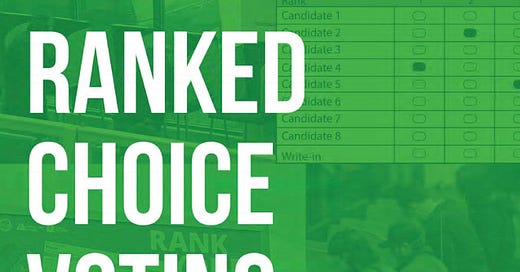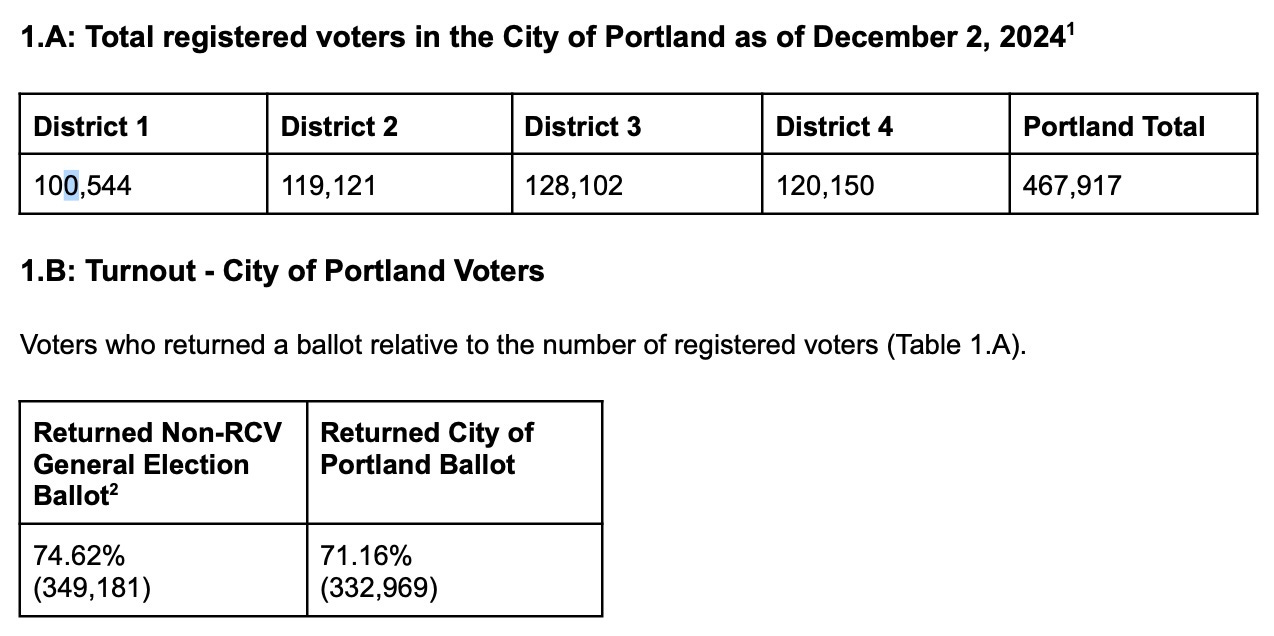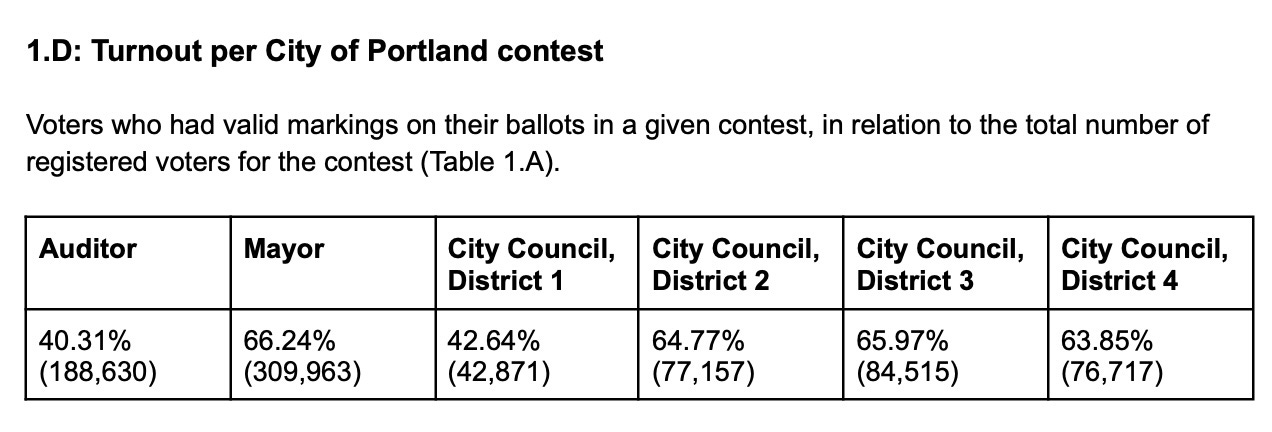Rank Choice Voting: Numbers Don't Lie--Do They Tell the Whole Story?
Multnomah county releases a long-awaited report. Get out your adding machine.
You may recall that just after the Nov. 5 election—the debut of two forms of rank choice voting—the Oregonian ran this blaring headline…
It was, if you read the Shane Dixon Kavanaugh story closely, a “newsroom analysis” that produced the shock-numbers, although you would look in vain for any mention of how the calculation was actually done. After all, some city council races were still being crunched by the computers in the county election’s bunker-like offices.
It did warm my cockles, since I had written here (Why I Won't Be (Rank Choice) Voting) that I wouldn’t be participating in the electoral fad; further warmth was provided by Oregon voters who turned thumbs down on rank choice1 , and by voters in Colorado, Idaho, Montana, Missouri, and Nevada who also said nyet. Most notably, despite the state being saturated by a billionaire’s ad blitz, Alaska voters repealed rank choice voting and, coincidentally, turned out the US Representative—a Democrat in the true-blue state—who fluked-in two years ago.
On Monday, the Multnomah county elections office released their report on the city’s RCV experiment…2
…which you can read here. Make sure you have a calculator handy, because finding the most important top-line number—134,948—requires some subtraction that the election office didn’t bother doing.
That’s the number of registered voters who didn’t return what the election office called, somewhat obliquely, the “city of Portland” ballot. Which was the RCV (for mayor) and STV (for council) ballot, and which was about the size of a small blanket.
Here’s how the election looked in the election office report…
As I’ve mentioned before, I got a D in 4th grade arithmetic…but, still. Of the city’s eligible voters (we hope they’re all citizens, right?), RCV laid an egg. By contrast, in 2020 (in a slightly larger city), turnout in the November election was 79.68 percent.
Of course (you can hear Candace Avalos saying this already), RCV’s weird sister, single transferrable vote, got 71.6-percent participation in the laundry-list city council balloting…3
But averages, as even a 4th-grade arithmetic student knows, can be misleading. The obvious eyebrow-lifter is district 1—the east side. Which, in the charter commission’s propaganda, was supposed to gain—bigly—from RCV…
Studies show that communities that have switched to Ranked Choice Voting have had an increase in voter participation. By giving voters more meaningful choices, they have more reason to vote.
…and…
Dividing Portland into districts so that elected leaders can represent geographic areas of the city instead of the entire city also creates a likely opportunity that residents, such as those in East Portland, who have been continually shut out from representation and political attention in city hall despite making up a large part of the city population and landmass…
…or so said the charter commission’s slick “Progress Reports.” Obviously, someone forgot to pick up the phone to district 1.
More fine print: the chart above shows the participation of people who actually played the RCV game and who voted. Which means (subtraction again) there were 45,405 people out there who didn’t bother with the RCV ballot. Reasons vary, of course, from laziness to forgetfulness to an aversion to anything governmental. But they went missing. Maybe they all read PortlandDissent.
These numbers hint that anyone claiming to “represent” district 1 should tune down any “I got a mandate” rhetoric; the computer-generated winner, Avalos, wound up getting only 10,718 votes, up from 8,297 first-choice votes on the first of 16 rounds of computer slicing-n-dicing, which—never forget—was computer-limited to no more/no less than 25-percent of the vote.
Even in district 2, 26.06-percent of the voters in a district with a large minority population didn’t bother with RCV. For the city, 28.84-percent of voters didn’t play the game.
Just to contrast: The Oregonian’s home-baked non-participation number was considerably lower…
From 17% to 29% of residents who voted in each of the city’s four new council districts — an average of 20% citywide — didn’t rank a single candidate to represent them…
The report abounds in more tricky DIY math; for example this graphic…
…followed by…
…note the words, “valid markings.” And note the difference between, again, the district 1 numbers. Somehow 12,268 voters disappeared between sending in a ballot and having “valid markings.” This hints that 22.25-percent of voters, in some way, messing up their RCV/STV ballots. Why? The report doesn’t speculate.
Opponents of RCV, however, complain that the complexity of the ballot itself discourages turnout.
Also note: despite RCV’s promise of greater voter participation, no district contest got higher participation than the vote for the shoo-in presidential candidate, Kamala Harris ( 325,927; 78.6-percent of the county vote). Even arch-villain Donald Trump got 70,759 votes in the county. Even after picking up second-best votes from vanquished candidates, Keith Wilson, our next mayor, got only 154,522 votes (up from 104,389 first round first-choices).
Some county voters are outside Portland(to their relief), but…still. Where did all of those voters go?
The report also listed something that it termed “undervotes”…
…which counts RCV ballots that were sent back, but not “marked.” Again, nearly a quarter of the voters out in district 1 stuffed the tablecloth-sized RCV ballot back in the envelope without participating—which doesn’t count (fine print again) those who tossed the RCV/Portland ballot in the trash.
Pols put into $133,000 per annum council jobs will no doubt argue that the numbers are just “growing pains” and that those high-70s participation numbers are nothing to worry about. There’s always another election to bring out the voters, along with the various unions, business associations, weirdo millionaires, and others endorsing and then cashing in.
Personally, I think the state’s voters smelled a rat and decided to let Portland have its usual goofy fun. And that a significant number of Portland voters were—take your pick…
Totally confused
Weirded out
Resistant to progressive daydreams
Alienated
Whatever the reason, we now have the numbers. Signed, sealed, recorded, archived.
We’re stuck with it.
They might have noticed that the state legislators who put the measure on the ballot exempted themselves from participating in the madness.
…and the county, starting the next election cycle.
The voting scheme that put three people from each of four districts into $133,00-a-year jobs with 25-percent (no more, no. less) of the vote.











Hard truths about the fraud that is RCV....
The Charter Commission’s goal was not to increase voter participation in POC heavy (or any) districts or to improve governance. It was to ensure that the voter advocacy and spending ($$$) by the far left unions (SEIU, PAT) and the bevy of nonprofits would be able to elect their candidates. It worked. There is one only moderate (Zimmerman) on the entire city council.